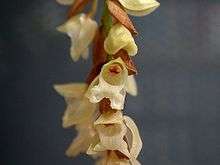Pholidota imbricata
Pholidota imbricata, commonly known as the common rattlesnake orchid[2] or necklace orchid,[3] is a plant in the orchid family and is a clump-forming epiphyte or lithophyte with crowded pseudobulbs. Each pseudobulb has a single pleated, leathery leaf and up to sixty white, cream-coloured or greenish, cup-shaped flowers in two ranks along a wiry flowering stem. There is a large, papery bract at the base of each flower. This species is native to areas from tropical and subtropical Asia to the southwest Pacific.
| Common rattlesnake orchid | |
|---|---|
 | |
| Scientific classification | |
| Kingdom: | Plantae |
| Clade: | Tracheophytes |
| Clade: | Angiosperms |
| Clade: | Monocots |
| Order: | Asparagales |
| Family: | Orchidaceae |
| Subfamily: | Epidendroideae |
| Tribe: | Arethuseae |
| Genus: | Pholidota |
| Species: | P. imbricata |
| Binomial name | |
| Pholidota imbricata | |
| Synonyms[1] | |
|
Synonyms list
| |
Description
Pholidota imbricata is an epiphytic or lithophytic, clump forming herb with crowded pseudobulbs 80–120 mm (3.1–4.7 in) long and 30–50 mm (1.2–2.0 in) wide. Each pseudobulb has a single pleated, leathery, dark green, oblong to lance-shaped leaf 200–400 mm (7.9–16 in) long and 60–80 mm (2.4–3.1 in) wide on a stalk about 50 mm (2.0 in) long. Between twenty and sixty cup-shaped, white, cream-coloured or greenish resupinate flowers 6–8 mm (0.24–0.31 in) long and 5–7 mm (0.20–0.28 in) wide are arranged in two rows along a wiry flowering stem 150–400 mm (5.9–16 in) long. There is a large, concave pinkish bract at the base of each flower. The dorsal sepal is 4–5 mm (0.16–0.20 in) long and 3–4 mm (0.12–0.16 in) wide, the lateral sepals 6–7 mm (0.24–0.28 in) long and about 3 mm (0.12 in) wide. The petals are 3–4 mm (0.12–0.16 in) long and about 1.5 mm (0.059 in) wide. The labellum is about 4 mm (0.16 in) long and 5 mm (0.20 in) wide and concave with three lobes. The side lobes are erect and the midlobe is divided again into three lobes. Flowering occurs between March and May.[2][3][4][5]
Taxonomy and naming
Pholidota imbricata was first formally described in 1825 by William Jackson Hooker who published the description in Exotic Flora.[6][7] The specific epithet (imbricata) is a Latin word meaning "overlapping like roofing-tiles and shingles".[8]
Distribution and habitat
The common rattlesnake orchid usually grows on trees and rocks in rainforest, sometimes in other humid, sheltered places. It occurs in China, the Indian subcontinent, Cambodia, Laos, Myanmar, the Nicobar Islands, Thailand, Vietnam, Borneo, Java, the Lesser Sunda Islands, Peninsular Malaysia, the Maluku Islands, the Philippines, Sulawesi, Sumatra, the Bismarck Archipelago, New Guinea, the Solomon Islands, Queensland, Fiji, New Caledonia, the Santa Cruz Islands and Vanuatu.[1] In Queensland it is found on some Torres Strait Island and on the Cape York Peninsula as far south as Townsville.[2][4]
References
- "Pholidota imbricata". World Checklist of Selected Plant Families (WCSP). Royal Botanic Gardens, Kew.
- Jones, David L. (2006). A complete guide to native orchids of Australia including the island territories. Frenchs Forest, N.S.W.: New Holland. p. 472. ISBN 1877069124.
- "Necklace orchid". Flowers of India. Retrieved 16 January 2019.
- "Pholidota imbricata". Trin keys: Australian Tropical Rainforest Orchids. Retrieved 17 January 2019.
- "Pholidota imbricata". Orchids of New Guinea. Retrieved 17 January 2019.
- "Pholidota imbricata". APNI. Retrieved 17 January 2019.
- Hooker, William Jackson (1825). Exotic Botany (Volume 2). Edinburgh: William Blackwood. pp. 138–139. Retrieved 17 January 2019.
- Brown, Roland Wilbur (1956). The Composition of Scientific Words. Washington, D.C.: Smithsonian Institution Press. p. 434.